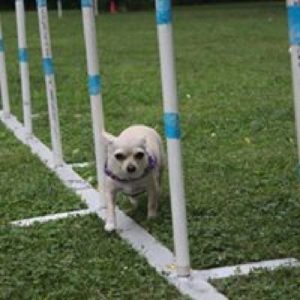“WHEN CAN I START AGILITY TRAINING?”
I get many calls asking me how old a puppy needs be to start agility training. My answer is “if your puppy is under the age of one he most likely can start PRE-agility training right now, but training that includes, repetitive behaviors, jumping and contact equipment needs to wait until the puppy is older.” Starting a puppy too young can permanently damage its joints. Puppies have soft bones, and unclosed growth plates. Exercise that is not appropriate for a puppy’s age can cause substantial and permanent damage.
What are growth plates and why do they matter? Growth plates are soft areas that sit at the ends of the long bones in puppies and young dogs. They contain rapidly dividing cells that allow bones to become longer. Growth plates gradually thin as the puppy approaches puberty which signals the growth plates to close (normally by 18 months). The only way to positively know if your pup’s growth plates are closed is by x-ray. Until the growth plates are closed, they are vulnerable to injury.
In addition, a puppy’s muscles and tendons are stronger that his growth plates. When performing a repetitive behavior, like jumping, if the puppy “lands wrong” and twists its leg, instead of incurring a simple sprain, the puppy’s soft tissue can pull apart his growth plate. Injuries to a puppy’s growth plate may not heal properly resulting in a shortened or misshapen limb and possibly make the puppy prone to more injuries when he grows up.
Puppies have soft bones! Like people, a puppy’s bones aren’t fully grown until after puberty. Repetitive behaviors, landing hard after a jump or when descending a piece of contact equipment (dogwalk, A-frame, teeter) could result in a fractured front leg. Spiral fractures are common in puppies and 50% of all fractures happen to puppies under the age of one. Any exercise that puts pressure or twists a puppy’s leg puts it at risk for fracture.
Flat-work (pre-agility) There are a ton of things that you and your puppy can work on before he ever gets on any equipment, and you can start when your puppy is as young as eight weeks. Work on attention, targeting, tug games, running through jump uprights. Use ground poles: straight line and grids, teach collection and extension. Introduce your puppy to lessons that teach body awareness: agility ladder, box work, walking over low bars on the ground, wobble board, Budja board. Play retrieves and sending to a target can teach your puppy distance. If you know handling skills work on those without equipment: front cross, rear cross agility heeling. Play with your puppy and build a strong relationship. Don’t forget: Attention. The list of things to do to prepare your puppy for a long agility career is endless.
Keep in mind that puppies don’t have the same endurance as an adult dog. Keep any training/play session short. Give your puppy ample time to rest throughout the day. Puppies grow up fast – enjoy each day and keep your puppy safe from injury.
I have known border collies and Australian shepherds that have had long healthy lives enjoying the sport of agility into their teens. Setting your puppy off on the right paw will do the same for him.

